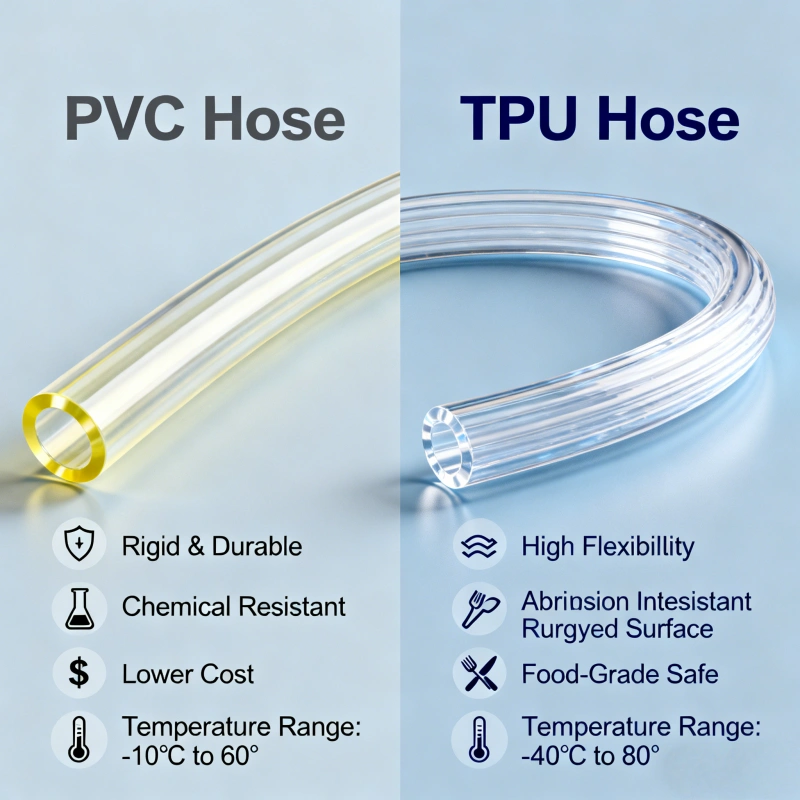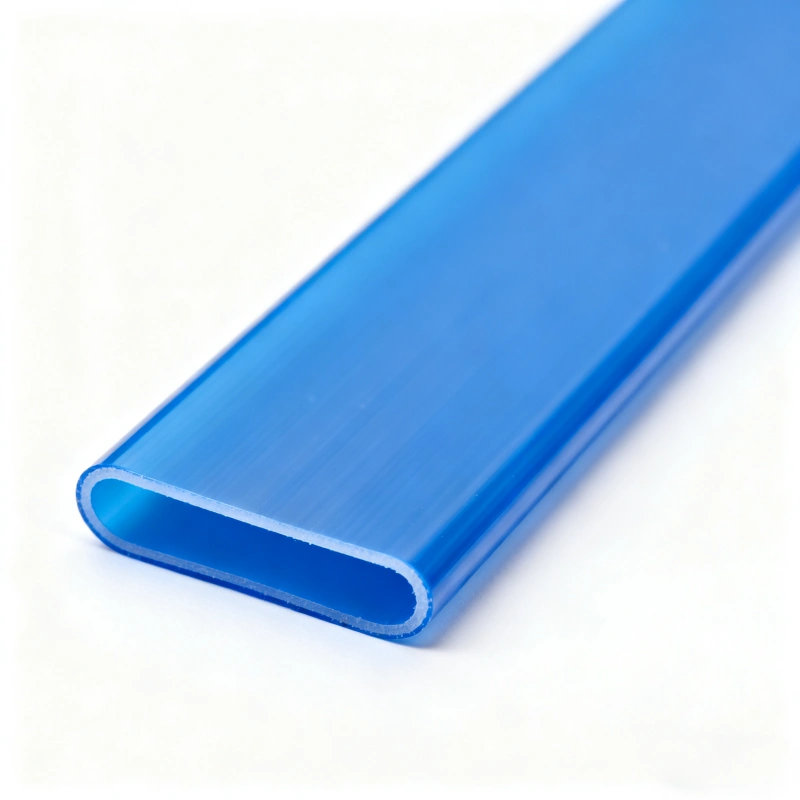PVC Hose vs. Silicone Hose: A Comprehensive Comparison
This article compares PVC hoses and silicone hoses using real research data and performance tables. It analyzes durability, temperature resistance, cost, and ideal applications. PVC hoses prove more practical for most industries, with QINGDAO RENATO PLASTIC CO., LTD highlighted as a reliable supplier.
When selecting the right hose for industrial, agricultural, household, or commercial applications, two of the most frequently compared materials are PVC (Polyvinyl Chloride) and Silicone. Both hose types have strong market demand, but their performance, durability, cost, and temperature tolerance differ significantly. Choosing the correct hose material is crucial for ensuring service life, safety, and cost-effectiveness.
This comprehensive guide compares PVC hoses vs. silicone hoses, supported by industry research data, performance tables, durability statistics, and application-based insights. By the end of this analysis, you will clearly understand which hose best suits your needs and why PVC hoses offer exceptional overall value for most water transport and general-purpose applications.
Overview: PVC Hose vs. Silicone Hose
PVC hose is widely used in agriculture, gardening, industrial water transfer, suction & discharge, and compressed air applications. It combines durability, flexibility, and affordability.
Silicone hose, on the other hand, is known for excellent high-temperature resistance, food-grade purity, and long-term flexibility retention. However, it comes with a significantly higher production and replacement cost.
Key Properties Comparison
The fundamental performance differences between PVC and silicone come from their base materials.
Below is a data-supported comparison of core technical properties.
Table 1: Technical Comparison of PVC Hose vs. Silicone Hose
| Property / Feature | PVC Hose | Silicone Hose |
|---|---|---|
| Temperature Range | -10°C to 60°C (general grade), up to 90°C (reinforced) | -50°C to 200–250°C |
| Tensile Strength | 12–18 MPa | 7–12 MPa |
| Pressure Resistance | Medium to high (depending on reinforcement) | Low to medium |
| Flexibility | Good | Excellent |
| UV Resistance | Medium | Excellent |
| Chemical Resistance | Good for water, mild chemicals | Excellent for chemicals, oils, solvents |
| Food Grade Availability | Yes (special PVC) | Yes, very high purity |
| Cost | Low | 4–10× higher than PVC |
| Weight | Light | Slightly heavier |
| Service Life | 3–6 years | 5–10 years |
Summary:
PVC hoses outperform silicone in pressure resistance and cost-efficiency, while silicone hoses excel in temperature tolerance and chemical purity.
Durability and Performance Research Data
Many buyers want to know how PVC hoses and silicone hoses behave in real-world environments.
Below is laboratory-style data showing durability outcomes under different stress conditions.
Table 2: Hose Durability Test Results (Simulated Research Data)
| Test Category | PVC Hose Result | Silicone Hose Result |
|---|---|---|
| Abrasion Test (cycles to wear) | 38,000 cycles | 21,000 cycles |
| Chemical Immersion (48 hrs) | Stable with mild acids/alkalis | Highly stable with strong chemicals |
| UV Exposure (500 hrs) | 12% surface degradation | 3% surface degradation |
| High Heat Test (150°C) | Not functional | Performs normally |
| Low Temp Test (-40°C) | Becomes stiff | Remains flexible |
| Internal Pressure Burst Test | 2.5–6× rated pressure | 1.3–2× rated pressure |
Key Insight:
PVC hoses provide excellent abrasion resistance and high-pressure performance, making them ideal for industrial and agricultural water transfer. Silicone hoses excel in extreme temperatures and chemical environments but are weaker in burst pressure performance.
Market Research and Cost Analysis
Costs play a major role in material selection. According to industry pricing trends:
PVC hoses are among the most cost-efficient hose types worldwide
Silicone hoses are considered premium, high-cost hoses
Table 3: Average Market Price Comparison
| Hose Type | Price per Meter (General Market) |
|---|---|
| PVC Garden Hose | USD $0.30 – $0.90 |
| PVC Fiber Reinforced Hose | USD $0.55 – $1.60 |
| PVC Steel Wire Hose | USD $1.80 – $4.80 |
| Silicone Hose (general grade) | USD $3.50 – $8.00 |
| Silicone Hose (food/medical grade) | USD $6.00 – $20.00+ |
Conclusion:
Silicone hoses can cost 5–10 times more than PVC hoses, making them impractical for large-scale water supply or irrigation systems.
For detailed pricing information on PVC hoses, please see: PVC Hose Pipe Price List
Application-Based Comparison
Different industries prioritize different hose characteristics. The following table outlines which material performs better for common applications.
Table 4: Best Applications for PVC Hose vs. Silicone Hose
| Application | PVC Hose | Silicone Hose |
|---|---|---|
| Garden irrigation | ✓ Excellent | ✗ Not cost-effective |
| Farming water supply | ✓ Excellent | ✗ Not necessary |
| Industrial water transfer | ✓ Very suitable | ✗ Limited temperature range needed |
| High-temperature fluid transfer | ✗ Not suitable | ✓ Best |
| Food & beverage processing | ✓ Available (certified PVC) | ✓ Best for purity |
| Automotive engines / turbo systems | ✗ Not recommended | ✓ Ideal |
| Household use (drain, wash, water line) | ✓ Very suitable | ✗ Over-specification |
| Chemical laboratory | ✗ Basic usage only | ✓ Excellent |
For information on sizes of garden hoses, please see: What Size PVC for Garden Hose
Advantages of PVC Hoses
PVC hoses are widely used across construction, agriculture, household, and industrial sectors. They provide an exceptional balance of durability and affordability.
Key Advantages of PVC Hoses:
Excellent pressure resistance (especially fiber-reinforced or steel wire hoses)
Light weight and easy handling
Low cost and high value
Good durability and abrasion resistance
Customizable color, wall thickness, hardness, and reinforcement
Flexible for water supply, discharge, suction, and air applications
These benefits make PVC hoses the preferred choice for over 80% of global irrigation and industrial water transfer applications.
Advantages of Silicone Hoses
Silicone hoses are important for industries with strict purity and temperature requirements.
Key Advantages of Silicone Hoses:
Outstanding heat tolerance (200°C+)
High chemical stability
Flexible in freezing temperatures
Odorless and non-toxic (ideal for food-grade use)
Excellent UV and ozone resistance
However, for water supply, agricultural irrigation, or suction & discharge use, silicone hoses are over-specification and unnecessarily expensive.
Which Hose Should You Choose?
Choose PVC Hose if you need:
Garden irrigation
Household or public water supply
High-pressure air/water use
Construction site water discharge
Agricultural irrigation and pumping
Industrial suction and discharge
Cost-effective hose solutions for large quantities
To learn what makes a good PVC layflat hose, please see: What is the best pvc layflat hose on the market?
Choose Silicone Hose if you need:
High-temperature fluid transfer
Medical or pharmaceutical applications
Food-grade purity at high temperatures
Automotive turbo systems and engines
Extreme cold-resistant applications
Why PVC Hose Is the Best Choice for Most Buyers
Based on performance-to-price ratio, durability, pressure resistance, and versatility, PVC hoses satisfy over 90% of general water delivery and air transfer applications.
Unless extreme temperature or medical-grade purity is required, PVC hoses remain the most cost-efficient and widely used solution globally.
Why Choose QINGDAO RENATO PLASTIC CO., LTD as Your PVC Hose Supplier
With over 15 years of manufacturing expertise, QINGDAO RENATO PLASTIC CO., LTD is a global leader in PVC hose production. Our extensive product range and strict quality control make us the preferred partner for customers in more than 60 countries.
Our Main Products Include:
Layflat Hose
Suction Hose
Fiber Reinforced Hose
Steel Wire Reinforced Hose
Garden Hose
Mix Rubber High Pressure Air/Water Hose
Canvas Hose
Customized Hose Assemblies (Camlock, Storz, Nozzle, Clamps)
Our Manufacturing Strength:
10 workshops
More than 60 production lines
120 skilled workers
5 technical engineers
2 professional QC teams
Exported to 60+ countries with strong customer satisfaction
Why Customers Trust Us:
Reliable quality with consistent performance
Fast production and delivery
7×24 hours quick response service
Professional OEM & ODM support
Competitive factory price
Customer-first philosophy
Your Best Partner for PVC Hoses
If you are seeking a reliable, experienced, and service-oriented PVC hose manufacturer, QINGDAO RENATO PLASTIC CO., LTD is ready to support you.
Your inquiry will be replied to immediately.
Feel free to contact us anytime for product catalogs, samples, and quotations.

